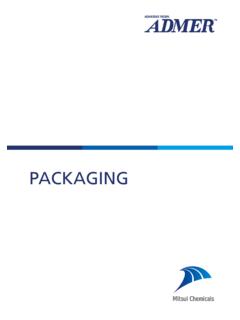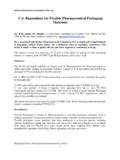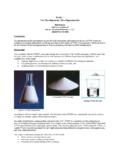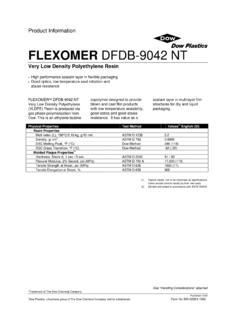Transcription of BARRIER ENHANCEMENT USING ADDITIVES …
1 BARRIER ENHANCEMENT USING ADDITIVES . Peter Maul President Nanocor, Incorporated Fillers, Pigments and ADDITIVES for Plastics in Packaging Applications Pira International Conference Brussels, Belgium December 5-6, 2005. Introduction Three decades of explosive growth have made plastic a dominant form of packaging worldwide. Among plastic's attributes are flexibility, clarity, low cost, shelf appeal, and ease of transport, storage and use. But the most important feature for food and beverage packaging is delivering to the consumer products that are fresh and safe. This often involves maintaining performance over long intervals between actual production and eventual consumption. This time interval, commonly known as shelf life , is increasing as food and beverage producers seek to distribute their products on a global basis and as plastics encroach upon areas previously the bastions of metal and glass packaging.
2 For many foods and beverages the limiting shelf life factor is the package's resistance to gas intrusion, exemplified by oxygen and water vapor. For other situations it is retention of gases, CO2 for example, and aromas. In either case the solution is providing BARRIER to the movement of molecules through the plastic matrix comprising the package. This paper overviews general approaches to enhancing plastic package BARRIER and provides details about the use of ADDITIVES to accomplish the goal. Particular emphasis is given to the role of nanotechnology in BARRIER packaging. General BARRIER Approaches Even novice package engineers know all plastics are permeable, and significant work has been done to devise ways to improve it. The most common approaches are outlined below.
3 Make a plastic article and coat it. Both flexible film and rigid containers are coated with ultra thin layers of materials that provide high intrinsic BARRIER . A variety of vapor deposition technologies are used to adhere coatings of aluminum and silicon oxides. A newer variant uses microwave plasma deposition to deliver amorphous carbon coatings onto the interior surfaces of beverage containers. Another approach consists of coating the outside surface of a package, usually a bottle, with high BARRIER epoxies, USING spray or dip technology. Coated articles have an established niche, but they are limited by the level of adherence between the coating and plastic substrate. The rigors of filling and transporting can compromise the coating and hence shelf life.
4 Exterior coatings can scratch off. Interior ones can crack or delaminate due to package creep after filling. Blend high BARRIER plastics into medium BARRIER ones. Modern compounding technology affords the engineer opportunities to blend high and medium BARRIER plastics. This cost-driven approach requires intimate incorporation so that small micelles of high BARRIER polymer are created and evenly distributed. Generally high BARRIER plastics have miscibilities and refractive indices quite different from their medium BARRIER hosts. Unfortunately, blend levels are only in the high single digits before clarity suffers, limiting this approach to shorter shelf life applications. -1- multilayer structures containing BARRIER layers. This approach has grown rapidly in the last decade.
5 It consists of embedding a thin (3-10%) layer of high BARRIER plastic within at least two layers of structural plastics. By properly choosing the candidates, one can fully utilize intrinsic BARRIER and protect the BARRIER layer from high relative humidity. Because the BARRIER is embedded, it is also protected from abrasion. Miscibility problems are avoided, and clarity is good. Layer adherence can be a problem and tie adhesives may be needed. Resins must be chosen with thermal stability and process window in mind. A final issue is recyclability, because BARRIER layers may need to be delaminated and removed before reuse. These limitations aside, a finished article can be filled and transported with ease. Long shelf life can be attained at reasonable cost.
6 Upgrade plastics with BARRIER -enhancing ADDITIVES . Although this concept is not new, it has only recently become feasible with the advent of advanced material technology. Two commercial approaches are in use: oxygen scavengers and nanoclays. As the additive term implies, the approach consists of incorporating functional materials directly into a plastic matrix, then USING the upgraded plastic as a component of an article. In the case of oxygen scavengers, the upgraded plastic may be the only component. In the case of nanoclays, it is usually, but not always, used as a BARRIER layer of a multilayer structure . Commercial oxygen scavengers are incorporated into PET or polyamides while commercial nanoclays are incorporated primarily into polyamides.
7 Because these ADDITIVES become part of the polymer matrix, concerns about adherence, scratching and delamination are virtually nil. The ADDITIVES are used at levels of 2-8% and they are miscible, so clarity is good. Oxygen Scavengers The moniker, scavenger is not scientifically correct because these products work by consuming oxygen in a classic oxidation reaction. An oxidizable plastic is used for the reaction, which is catalyzed by a transition metal, usually cobalt1. Typically the oxidizable plastic is PET. or polyamide. The reaction is triggered by humidity moving through the plastic matrix. Oxygen scavengers are called active systems because the reaction begins immediately upon exposure to humidity and of course oxygen. They become active and stay active until there is insufficient catalyst to sustain the oxidation reaction.
8 At this point they are spent. Therefore oxygen scavengers have a specific life after which they cease to provide meaningful BARRIER . However, scavengers are highly effective at removing oxygen, especially during the first half of their life cycle. Scavengers not only remove oxygen as it ingresses into the package, but also as it egresses from the package headspace into the wall. And because dissolved oxygen in beverages tends to migrate into the package due to gradient affect, it is likewise removed. In a properly designed package and under the right conditions, scavengers can easily hold product oxygen at 1ppm for a six month shelf life. BARRIER performance for active systems is highly dependant on package surface area/volume ratio. Large surface/volume limits cost effective performance.
9 For this reason oxygen scavengers have primarily been used for bottled products. -2- There are five significant producers, offering scavenging systems in different formats. One offers the scavenger in a PET masterbatch, which can be dosed into any bottle grade PET during manufacture. Another supplies the entire PET resin containing scavenger. A third offers scavenger incorporated into a polyamide blend for use as the BARRIER layer in multilayer bottles. Finally, two bottle producers sell multilayer bottles containing proprietary scavengers in the polyamide inner-layer. Scavenger Products & Producers: PRODUCT REGION PRODUCER RESIN BASE WEBSITE. (FORMAT). Amosorb All ColorMatrix PET DFC (Masterbatch). Polyshield Europe Invista PET (Resin). Aegis OX All Honeywell Polyamide Blend www.
10 (Resin). Oxbar All Constar Polyamide MXD6 (Bottle). Bindox Europe Amcor Polyamide MXD6 (Bottle). Nanoclays Nanoclays refer to a category of clay minerals with a specialized structure , characterized by a platey morphology. The platelets have submicron dimensions, excepting their thickness, which is only about one nanometer. This dimensional disparity results in large aspect ratio, a property conducive to BARRIER ENHANCEMENT based on the principle of tortuous path Tortuous Exfoliated Path Platelets Polymer Film -3- Nanoclays create a passive BARRIER by impeding the diffusion of gases and aromas as they attempt to permeate through a plastic matrix. In this manner they differ from oxygen scavengers. Rather than being specific to just one gas, ie oxygen, passive barriers impede all gases to one degree or another.





